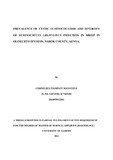| dc.description.abstract | Cystic Echinococcosis is a serious zoonotic disease caused by Echinococcus granulosus species
complex. This research study was conducted to determine the level of infection of the disease in
sheep in Olokurto division, Narok County, Kenya. The study area was divided into five locations
and 180 sheep selected randomly from each location were inspected for infection. Sample
collection was conducted in Likia slaughter house. The carcass of each sheep was inspected
carefully for the presence of hydatid cysts, infection and the organs infected and the number of
cysts was recorded. The sheep identification number and sex, and age as determined by dentition
were also recorded. Hydatid cysts collected were preserved in 70% ethanol and transported to the
laboratory for analysis. In the laboratory, cysts size and volume of hydatid fluid were measured,
microscopic examination of hydatid fluid was performed to determine cysts fertility, and species
identification was determined following restriction digests of amplified PCR products which
targeted the NADH dehydrogenase subunit 1 (nad-1) gene. Overall prevalence was 16.0%
(144/900), infection rates in the five sampling sites were significant (P<0.05), with the liver
being the most infected organ (50.7%), followed by the lungs (36.8%), while mixed infections
involving the liver and the lungs were detected in12.5% of the sheep sampled. PCR/RFLP results
revealed that all strains were E. granulosus sensu stricto which means that the genotype is G1
(genotype1). The cysts were examined under the microscope to determine fertility, out of the 343
hydatid cysts collected and examined, 62.1% of the hydatid cysts were fertile, 35.2% were sterile
while 2.7% were calcified. Lung cysts were found to be more fertile (73.02%) compared to liver
cysts (53.4%). There was a direct relationship between age, number and size of hydatid cysts as
the number and size of the cysts increase with increase in age of the sheep. Since all strains were
G1 which is particularly pathogenic to humans, it is importance to control the disease | |

